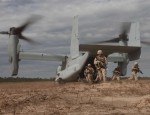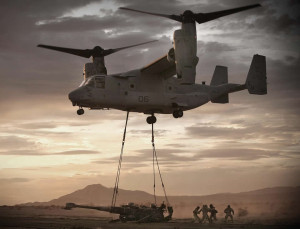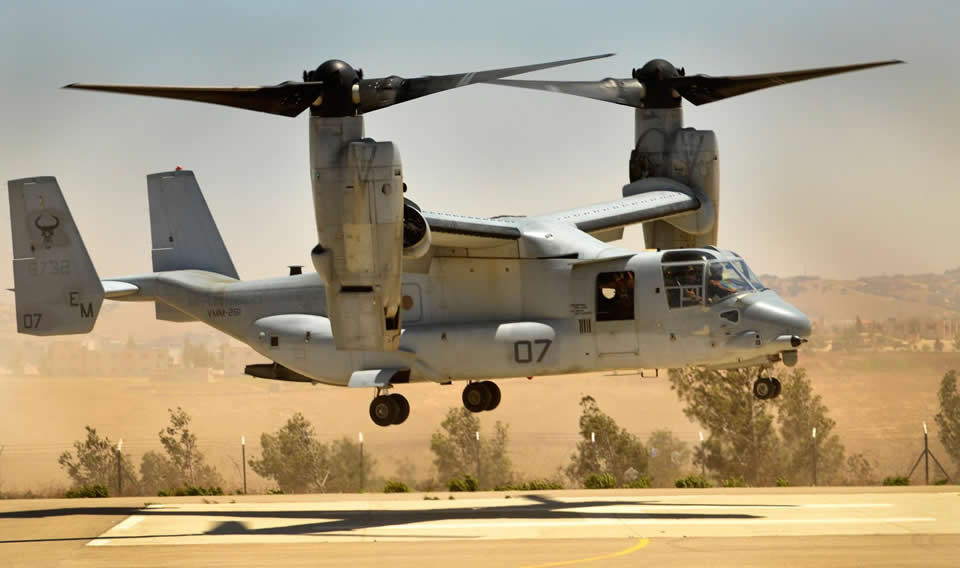
The planned deployment of US Marine Corps MV-22B Osprey tiltrotor transport aircraft to Okinawa has run into some rather intense opposition from local Japanese officials and created new headaches for Japanese Prime Minister Toshihiko Noda. Two Japanese prefectural governors, along with local community leaders, have adopted a stance of direct opposition to the planned deployment of the Osprey.
The untimely crash of a US Air Force Special Operations Command (AFSOC) CV-22B in Florida earlier this week that left five servicemembers injured and an April crash of a Marine MV-22B in Morocco that killed two Marines have left many Japanese doubting the safety of the aircraft. According to the Pentagon, preliminary accident reports indicate that mechanical failure was not the cause of either accident.
As a tiltrotor aircraft capable of vertical/short take-off and landing (VSTOL) operations, the Bell Boeing V-22 was designed to integrate the features of a conventional helicopter with those of a turboprop aircraft. This innovative combination of functionality gives the Marine Corps a long-range, high-speed aircraft that outperforms existing medium-lift helicopters currently in active service. The Osprey is able to carry as many as 24 combat-loaded Marines at twice the speed and five times the distance of operational helicopters of comparable lift capacity.
The MV-22B is a medium-lift transport aircraft and has been employed as a combat transport in a battlefield environment in both Iraq and Afghanistan since 2007. Having encountered both shoulder-launched missiles and antiaircraft fire on combat-lift missions, not a single aircraft has been lost to enemy fire.
As a hybrid, the MV-22B features the maneuverability, speed, and range of a turboprop transport while offering the VTOL capabilities of a conventional helicopter. It gives the US Navy and Marines a medium-lift capability that can be launched against a hostile shore from a greater distance to enhance the survivability of amphibious assault shipping, a consideration that may become a significant concern in the Asia-Pacific region.
In the early stages of development the V-22 was plagued by a series of technical difficulties, glitches the Marine Corps says were little more than initial teething problems that have since been identified and corrected.

Added to the technical complications was the unfortunate nickname of “widow-maker” the Osprey was tagged with as a result of a series of accidents that occurred during flight testing. The aircraft suffered four serious crashes during flight testing between 1991 and 2000 costing the lives of 30 people aboard the aircraft. Since the Osprey became operational in 2007, six people have died in three accidents and several others were injured.
It is this safety record, a media favorite and always accorded front-page coverage, which has rattled Japanese leaders and inflamed an already tense situation with respect to the US military presence in Japan, especially among the Okinawan populace.
Following the CV-22B crash in Florida on 13 June, Japan’s newly-appointed Minister of Defense, Satoshi Morimoto representing the Japanese government, requested the Pentagon provide a detailed briefing to explain the causes of the Florida accident and the 22 April crash of the Marine MV-22B in Morocco. Japanese national leaders are under unrelenting pressure to assure community leaders and the general public that the Osprey can be operated safely in japan.
In response to this request, Pentagon officials and military officers gave a presentation to Japanese representatives on 22 June to provide an update on the details of the most recent Osprey accidents and to assure the Japanese that the MV-22B’s safety record equals that of any active aircraft in the military’s inventory.
During the high-level meeting, held in a Washington suburb, Defense Department representatives defended the safety record of the Osprey and shared preliminary investigation findings concerning the two most recent Osprey accidents with their Japanese counterparts.
Department of Defense (DoD) Press Secretary George Little said in a statement that the meeting offered US officials an opportunity to provide Japanese representatives an update “on the status of the investigations into recent aircraft mishaps.” The purpose, of course, is to reassure the Japanese that the Osprey, although a new and innovative aircraft, can be operated from multiple platforms with greater safety than can be achieved with helicopters.
Mr. Little told reporters that the Pentagon “takes the inquiries made by the Japanese government very seriously and provided relevant information to the extent currently possible, and will continue to do so.” He went on to say that the “Osprey is a highly capable aircraft with an excellent operational safety record, which includes more than five years of worldwide deployments and 140,000 flight hours.” The Pentagon stands behind its decision to deploy the MV-22B to Okinawa and insists that there are no plans in the works to cancel this deployment. Mr. Little was quoted as saying that the United States expects “to continue our deployment of MV-22 Ospreys to Okinawa.”
Japanese representatives were also informed that the Lieutenant Colonel responsible for CV-22B training in Florida was relieved of his duties following the USAF Osprey crash on 13 June, a seeming reference to a training failure and not a design flaw.
The original deployment plan called for the Ospreys to be assembled and undergo flight testing at the Marine Corps Air Station (MCAS) in Iwakuni, Yamaguchi Prefecture before being sent on to MCAS Futenma in Okinawa. On 19 June, Okinawa Governor Hirokazu Nakaima met with Foreign Minister Koichiro Genba and Defense Minister Satoshi Morimoto to ask the central government to encourage the Pentagon to cancel deployment of the twenty-four Ospreys to Futenma.
Iwakuni City Mayor Yoshihiko Fukuda announced on 12 June that the city was forbidding the temporary flight testing of the MV-22Bs at MCAS Iwakuni due to safety concerns highlighted by the Osprey crash in Morocco. With the CV-22 crash in Florida on 13 June, Mayor Fukuda convinced the City Assembly to endorse a formal nonbinding motion strongly opposing the temporary basing of the Ospreys at MCAS Iwakuni on 22 June. Yamaguchi Governor Sekinari Nii has lent his support to the Iwakuni opposition as well. Also on 22 June, Naha Mayor Takeshi Onaga and other Okinawa community officials traveled to Tokyo to present their opposition to the Osprey deployment and to request the Foreign Ministry also pressure the US government to cancel the deployment.
Earlier this year, the United States and Japan agreed to a new plan that calls for the Marine Corps to permanently remove 9,000 Marines from Okinawa and redeploy them to Hawaii and other Pacific locations. Both nations agreed to continue plans to relocate MCAS Futenma operations to another site with the latest idea to move the air facility to an offshore location in a less-inhabited area of Okinawa still the first choice.
Despite these efforts, the US military presence in Japan remains a contentious issue that frequently inspires mass public protests in Okinawa. The proposed relocation of the Futenma facility is a matter that remains unresolved and is likely to fuel future protests regardless of what alternative site is selected for the relocation.
While it is not necessary for local communities to approve of the Osprey move, the hostile opposition the plan has generated represents a serious loss of face for the national government and Prime Minister Noda. The opposition also complicates the Pentagon’s ongoing project to upgrade Marine Corps air assets. The MV-22B/C is projected to replace the aging fleet of CH-46 Sea Knight medium-lift helicopters now operational with an estimated completion date of 2019.
The last Marine CH-46 pilot completed training this year and no additional pilot training is scheduled. The Marine Corps is committed to the Osprey and, barring any extraordinary developments, it is the transport of the future. No alternative aircraft are available to replace the Osprey and it is not practical to believe that production could be increased on a conventional helicopter model to perform the Marine’s transport mission.
Should the Marines in Japan be denied the Osprey, it would deprive them of a critical component in their warfighting capabilities, power projection abilities, and would cripple their humanitarian relief efforts. Unit and personnel rotation from other regions of the world would be rendered impossible since the CH-46 will be retired and the Marines already have twelve squadrons flying the MV-22. Simply put, without the Osprey the Marines will be unable to perform their mission from Japanese installations. Either the Japanese accept the Osprey or the Marines may be forced to begin looking for another base of operations, a time-consuming and extremely difficult option.





















